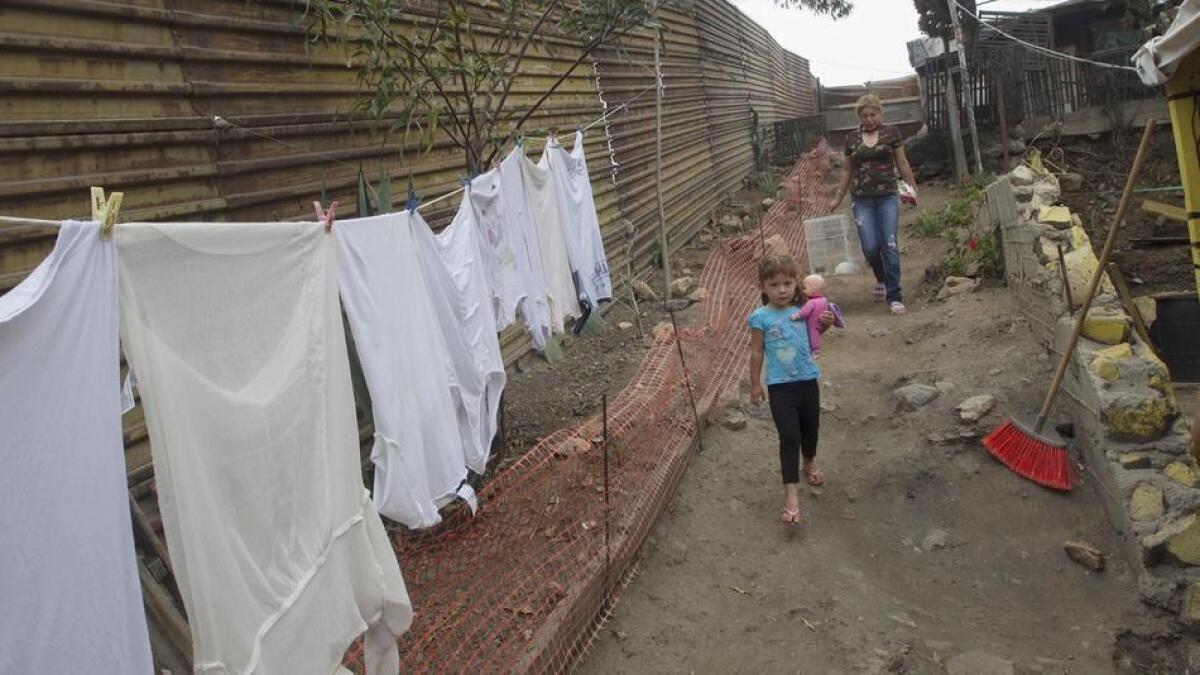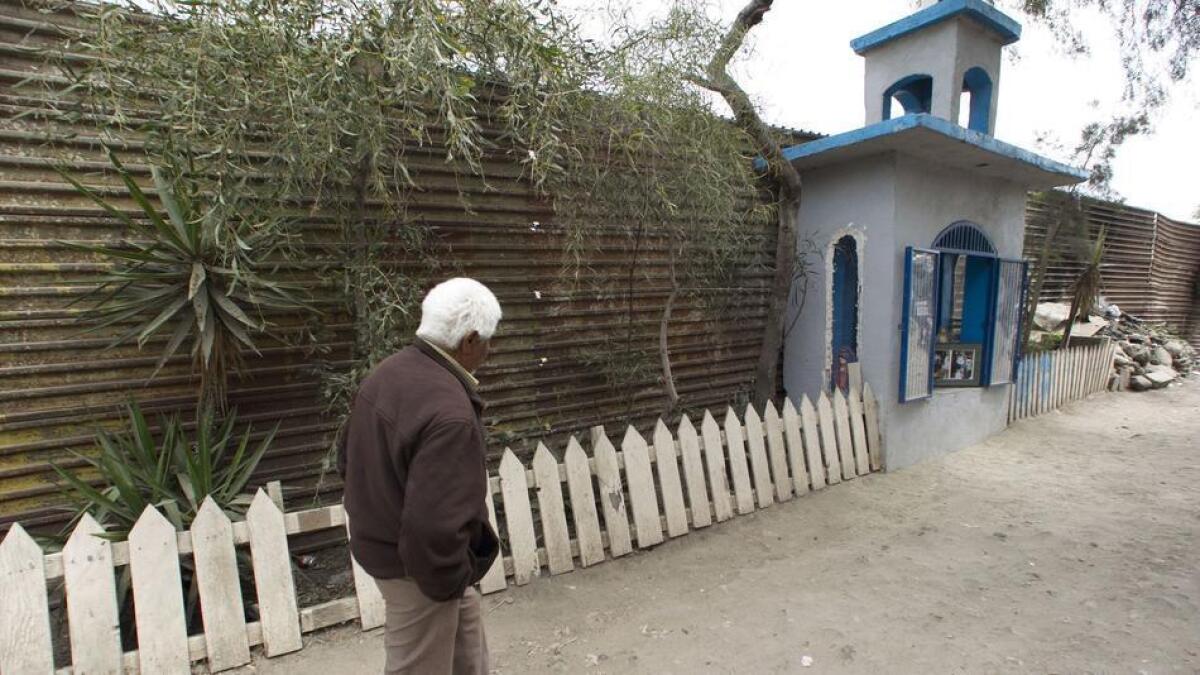Tijuana residents face loss of homes, patios and even a shrine as new border wall rises

- Share via
Reporting from Tijuana — From property barriers to wood shacks to cluttered backyard patios, dozens of structures south of the U.S. border fence face demolition as the Trump administration moves forward on its plans to build a taller, stronger wall separating the United States from Mexico.
The likely loss of property in Mexico has become a sore point as work gets underway on a $147-million U.S. government project to replace about 14 miles of the scrap-metal border fence between Tijuana and San Diego. The new structure is a bollard-style barrier rising 18 to 30 feet, topped with an anti-climbing plate and described as “one of the Border Patrol’s top priority projects.”
At the far western end of the project, about 20 property owners in an enclave in Playas de Tijuana have been ordered by the municipal government to remove structures built close to the fence, some that are deemed to be encroaching on U.S. territory. Farther east in Colonia Libertad, bulldozers already have begun removing trees in a residential neighborhood south of the border fence.

At Tijuana’s northeastern edge, residents of the impoverished Nido de las Aguilas neighborhood say they are worried they might lose their homes.
“You might say these boards are ugly, but for us they are everything,” said Beatriz Esparza, 41, who lives in a room her late husband built with scrap wood next to the border fence. “The president of the United States, maybe he has a lot of money, but we are poor.”
Authorities in Mexico do not have a definitive count, but expect the construction of the new U.S. barrier will displace dozens of structures, including concrete block walls, wooden shanties, outhouses, patios, animal enclosures, a carport, a tennis court and a shrine with an image of the Virgin of Guadalupe that is attached to the existing wall. Trees and gardens also are expected to be uprooted.
“The fact that they are on the Mexican side of the wall does not mean that they’re in Mexico,” said Roberto Espinosa. He heads the Tijuana office of the Mexican counterpart of the U.S. International Boundary and Water Commission, a binational agency that oversees compliance with water and boundary treaties.
“People think that the fence is the boundary line and that is not so,” Espinosa said.
The existing border fence typically stands about 2 or 3 feet inside U.S. territory. The new fencing project will follow the same line as the old one, but it will be larger and heavier, thus requiring removal of any trees and structures in its way, authorities said.
Acting at the request of the Mexican branch of the boundary commission, the city sent out initial notices in April to 20 property owners in Terrazas de Mendoza, a quiet and gated enclave of several dozen houses that offers sweeping views of the Pacific Ocean.
The San Diego Union-Tribune was able to see a notice that informed one owner that her property’s mesh fence, arch-shaped wall and tennis court were “affecting the border line.”
Legally, there should be no construction within about 65 feet of the border, said Leopoldo Guerrero, the second-highest-ranking official at Tijuana City Hall. But authorities say that in this case, they are asking only that property owners clear out structures within one meter of the border fence, or roughly 3.3 feet.
This month, the city sent out a second notice. “Right now, it’s a recommendation,” Guerrero said. “We’re telling them, ‘I’m giving you the opportunity to do this’ and let them work, so that [they] can’t come back later and complain,” if the structures end up being torn down by the U.S. contractor charged with building the new barrier.
Although the issue arose with the construction of the new wall, its origins go back more than a century. Both the U.S. and Mexican sides of the commission in 1906 recommended that their governments establish 60-foot strips along both sides of the international boundary forbidding private residences or similar constructions.
A year later, President Theodore Roosevelt issued a proclamation ordering a 60-foot-wide strip to serve “as a protection against the smuggling of goods between the United States” and Mexico. The parcels “may be used for public highways but for no other purpose whatsoever,” it said.
Mexico took similar action in 1943, with a Finance Ministry decree stating that structures by the boundary line “lend themselves to hiding subjects who are violating the laws of the country due to the easy reach to the borders of other countries.”
Yet, over the decades, people have built up right to the barrier.

In Colonia Libertad, longtime resident Jose Arias faces destruction of a concrete block shrine to the Virgin of Guadalupe that he says memorializes his late wife and son and is attached to the existing border fence. Nearby, bulldozers already have begun pulling down trees and the shrine is expected to come down when the old border fence is removed.
Guerrero, the city official, said authorities are working gradually on notifications as the wall construction progresses — and residents like Juana Nava in Nido de las Aguilas say they have yet to receive word.
On the small plot at the end of Calle Cilantro where she lives with her eight children and three grandchildren, Nava has built a washroom and outhouse right against the wall, and in another spot she has created a shaded patio area with a hammock. Outside her fence of scrap wood, she has planted a garden of nopal cactus.
“I have papers, I have water, I have electricity, look at the post, I’m not lying to you,” said Nava, who earns money cleaning houses. If she has to move, “let them give me what I’ve invested,” she said.
The neighborhood, settled by squatters, for years has been known as a corridor for smugglers, and those who live by the fence say they regularly see people climbing into the United States. But apart from the sounds of U.S. Border Patrol vehicles, residents like Nava say this is a quiet spot.
The president of the United States, maybe he has a lot of money, but we are poor.
— Beatriz Esparza, whose home is threatened by border wall
Standing outside her house near cages of chirping parakeets, Esparza, the widow, offered a visitor a glass of water and a seat in the shade as she spoke of her worries.
Since her husband died three years ago, she has lived here with her adolescent son, 21-year-old daughter, 3-year-old granddaughter and a stray dog named Africa, who was rescued from a nearby dump. Esparza learned about the new wall from TV coverage.
“They’re just old boards, but it’s our home,” Esparza said of her one-room residence. “I don’t want them to come and destroy what we’ve built with so much sacrifice.”
sandra.dibble@sduniontribune.com
More to Read
Sign up for Essential California
The most important California stories and recommendations in your inbox every morning.
You may occasionally receive promotional content from the Los Angeles Times.













